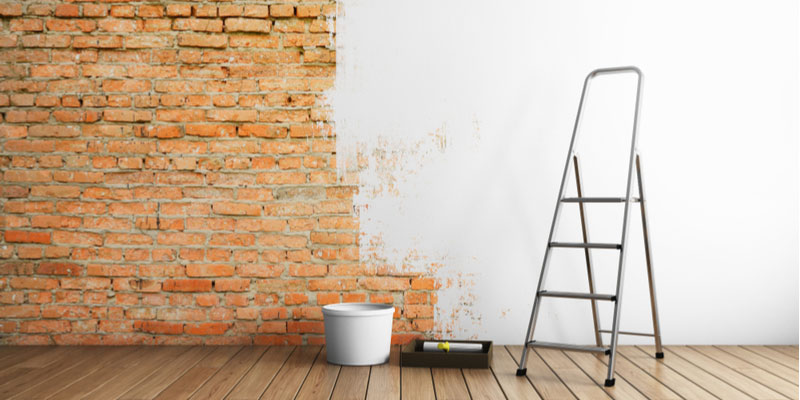Painting an interior brick wall might seem like a great idea in theory but there are a few things to consider before you take the plunge. For starters, it’s next to impossible to completely remove paint from brick without damaging it. Also, painted brick walls require a good deal of maintenance work.
Not that we don’t appreciate a good-looking painted brick wall, but it’s important to understand the potential drawbacks of adding paint to brick. Not to mention, there are other options to consider. For instance, a brick stain can change the look of brick without painting over it.
5 Things You Need to Know Before Painting Interior Brick
If you want to paint an interior brick wall, here are some things to consider before making any final decisions.
#1. Paint traps moisture, which means it’s not great for brick
Bricks contain natural pores that absorb and release moisture. Applying thick coats of paint over brick causes it to lose its breathable qualities. Therefore, paint effectively traps moisture into the wall. Luckily, interior walls are less likely to take in excess moisture, so this would be an even larger concern for an exterior wall. Although, it can still present challenges for interior walls; for instance, high humidity can cause a buildup of moisture.
Once moisture is trapped in brick, it will continually go through freeze and thaw cycles during the winter months as temperatures shift above and below freezing. The moisture solidifies and then melts, over and over, this expanding and shrinking puts pressure on brick and ultimately leads to cracks.
Look for bubbling or blistering beneath painted surfaces, this is a sign that a painted brick wall contains trapped moisture.
Still, if you’re going to paint any wall, it might as well be an interior wall because it’s far less susceptible to water damage.
#2. Is your brick wall a good candidate for paint?
Not all brick walls are good candidates for a coat of paint. If brick is moldy, chipped, deteriorating, or in bad condition, experts warn against painting it. The paint will only make problems worse and from there things can start to get messy. Before adding paint, you must resolve brick issues, restore mortar, replace moldy bricks, and so forth.
#3. You’ll need to repaint again, and then again
Once you paint an interior brick wall, you have a new chore on your to-do list. The wall will need to be repainted once every three to five years. Paint doesn’t always do great on brick. In fact, paint tends to be less durable when used on bricks. In most cases, you’ll need to use an alkaline-resistant primer to prevent the alkalinity of the mortar from impacting the paint.
#4. Will you want to take the paint off at some point?
Brick is a porous material. Therefore, it absorbs paint right through the first layer – staining the brick so that it is difficult, if not impossible, to restore the original brick color. To remove the paint, you’ll likely need chemicals and abrasive scrubbing methods, which will damage the top protective layer of the brick and leave it more vulnerable to damages over time. This could devalue a building where classic brick plays a role in the historic charm of the place.
#5. Painting brick requires proper equipment & technique
Brick walls aren’t as easy to paint as other surfaces. Properly applying the right type of paint, primer, and finishing coat is a job best left to the professionals. The quality of work done will influence how the paint holds up overtime.

